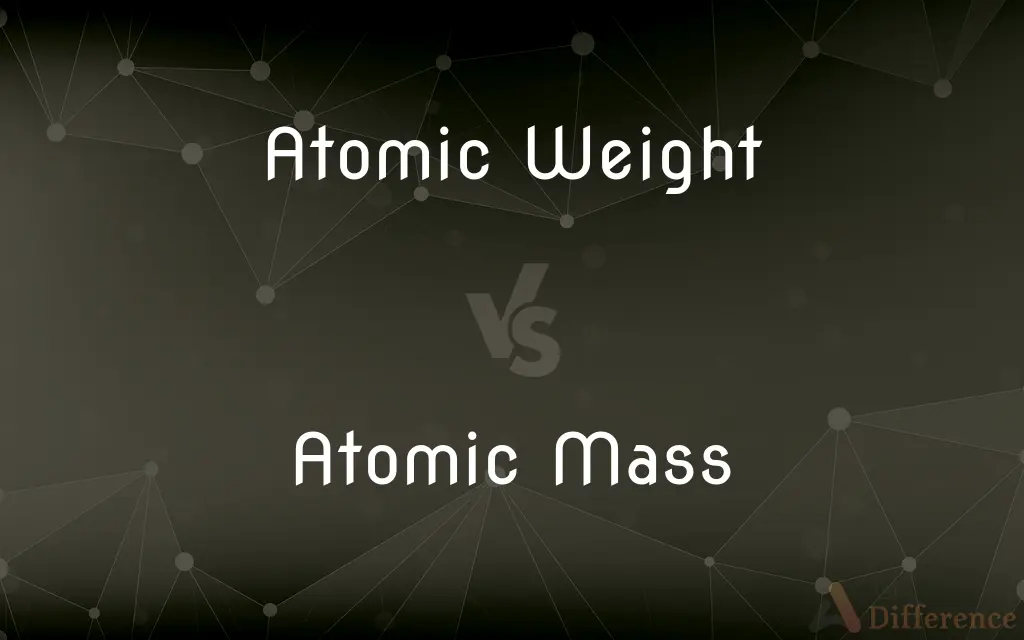Atomic Weight vs. Atomic Mass — What's the Difference?
By Tayyaba Rehman — Published on January 14, 2024
Atomic Weight and Atomic Mass are often used interchangeably, but there's a subtle distinction. Atomic Weight includes the effects of isotopic abundance, while Atomic Mass is the average mass of atoms in a sample.

Difference Between Atomic Weight and Atomic Mass
Table of Contents
ADVERTISEMENT
Key Differences
Atomic Mass: Atomic Mass is the mass of a single atom of a chemical element. It is often expressed in atomic mass units (u) or daltons (Da). Atomic Mass is based on the mass of the protons, neutrons, and electrons in an atom. It's essentially the mass of a specific isotope of an element, typically the most abundant one. For example, the Atomic Mass of carbon is approximately 12 u, which refers to the most common carbon isotope, carbon-12.
Atomic Weight: Atomic Weight is the average relative mass of the atoms in a naturally occurring sample of an element, taking into account the abundances of all its isotopes. Unlike Atomic Mass, which focuses on a specific isotope, Atomic Weight considers the weighted average of all isotopes. It is a more practical value for chemistry because it reflects the real-world mixture of isotopes. Atomic Weight is also expressed in atomic mass units (u) or daltons (Da).
Isotopic Abundance: The key difference lies in isotopic abundance. Elements can have multiple isotopes with different numbers of neutrons. These isotopes occur in different proportions in nature. Atomic Mass focuses on one specific isotope, while Atomic Weight considers the contributions of all isotopes based on their natural abundance.
Comparison Chart
Definition
Mass of a single atom of an element.
Average mass of atoms in a naturally occurring sample, considering all isotopes.
Focus
Specific isotope (usually the most abundant).
Weighted average of all isotopes based on abundance.
ADVERTISEMENT
Units
Expressed in atomic mass units (u) or daltons (Da).
Expressed in atomic mass units (u) or daltons (Da).
Application
Theoretical, idealized value.
Practical, reflects real-world mixture of isotopes.
Example
Atomic Mass of carbon-12 is 12 u.
Atomic Weight of carbon is approximately 12.01 u.
Compare with Definitions
Atomic Weight
Represents the theoretical mass of an atom.
The Atomic Mass of sulfur-32 is 31.97 u.
Atomic Mass
Expressed in atomic mass units (u) or daltons (Da).
The Atomic Weight of hydrogen is about 1.01 u.
Atomic Weight
It focuses on the mass of a specific isotope.
The Atomic Mass of chlorine-35 is 34.97 u.
Atomic Mass
Reflects the real-world isotopic distribution.
The Atomic Weight of neon is influenced by its various isotopes.
Atomic Weight
Expressed in atomic mass units (u) or daltons (Da).
The Atomic Mass of oxygen-16 is 16.00 Da.
Atomic Mass
Atomic Weight is the average mass of atoms in a naturally occurring sample.
The Atomic Weight of chlorine is approximately 35.45 u.
Atomic Weight
Often used in nuclear physics and research.
Atomic Mass is crucial in nuclear reactions.
Atomic Mass
Considers all isotopes and their abundances.
Atomic Weight accounts for the mixture of chlorine-35 and chlorine-37.
Atomic Weight
Atomic Mass is the mass of a single atom of an element.
The Atomic Mass of hydrogen-1 is approximately 1 atomic mass unit (u).
Atomic Mass
Practical value used in chemistry.
Atomic Weight is essential in stoichiometry calculations.
Common Curiosities
What is Atomic Mass?
Atomic Mass is the mass of a single atom of an element, often expressed in atomic mass units.
Why do elements have different isotopes?
Elements have different isotopes because of variations in the number of neutrons in their nuclei.
Which isotope is typically used for Atomic Mass?
Atomic Mass usually refers to the most abundant isotope of an element.
How is Atomic Mass determined?
Atomic Mass is determined by summing the masses of protons, neutrons, and electrons in an atom's nucleus and electron cloud.
What are atomic mass units (u) or daltons (Da)?
They are units used to express the mass of atoms on a molecular scale.
Why is Atomic Weight important in chemistry?
Atomic Weight is crucial in chemical calculations, such as stoichiometry and molar mass determination.
What is Atomic Weight?
Atomic Weight is the average mass of atoms in a naturally occurring sample, considering all isotopes and their abundances.
Why is Atomic Weight more practical than Atomic Mass?
Atomic Weight reflects the real-world mixture of isotopes found in nature, making it more applicable in chemistry.
Are Atomic Mass and Atomic Weight constant for all samples of an element?
No, they can vary slightly due to differences in isotopic composition.
How is Atomic Weight calculated?
Atomic Weight is calculated by considering the natural abundance and mass of all isotopes of an element.
Do all elements have Atomic Weight values?
Yes, all elements with more than one isotope have Atomic Weight values.
Can Atomic Weight be a fraction?
Yes, Atomic Weight can be a fractional value when isotopes have fractional abundances.
Is Atomic Mass the same as molar mass?
No, Atomic Mass is the mass of a single atom, while molar mass is the mass of one mole of atoms.
How do scientists determine the abundances of isotopes?
Scientists use various methods, including mass spectrometry, to measure isotopic abundances.
What is the significance of Atomic Mass and Atomic Weight in the periodic table?
They help in understanding the atomic structure and behavior of elements in chemical reactions.
Share Your Discovery

Previous Comparison
Constructivism vs. Cognitivism
Next Comparison
Iterator in Java vs. ListIterator in JavaAuthor Spotlight
Written by
Tayyaba RehmanTayyaba Rehman is a distinguished writer, currently serving as a primary contributor to askdifference.com. As a researcher in semantics and etymology, Tayyaba's passion for the complexity of languages and their distinctions has found a perfect home on the platform. Tayyaba delves into the intricacies of language, distinguishing between commonly confused words and phrases, thereby providing clarity for readers worldwide.













































